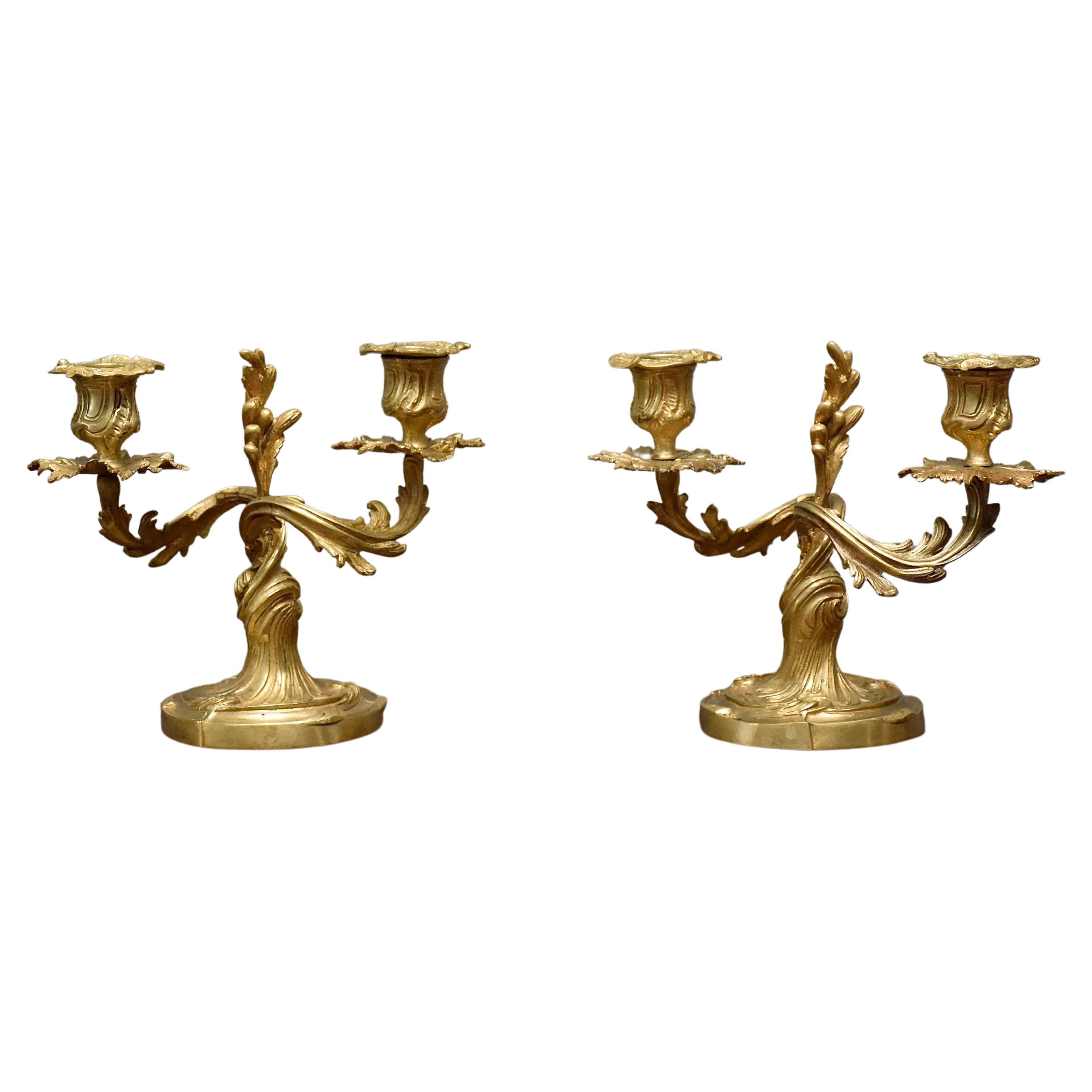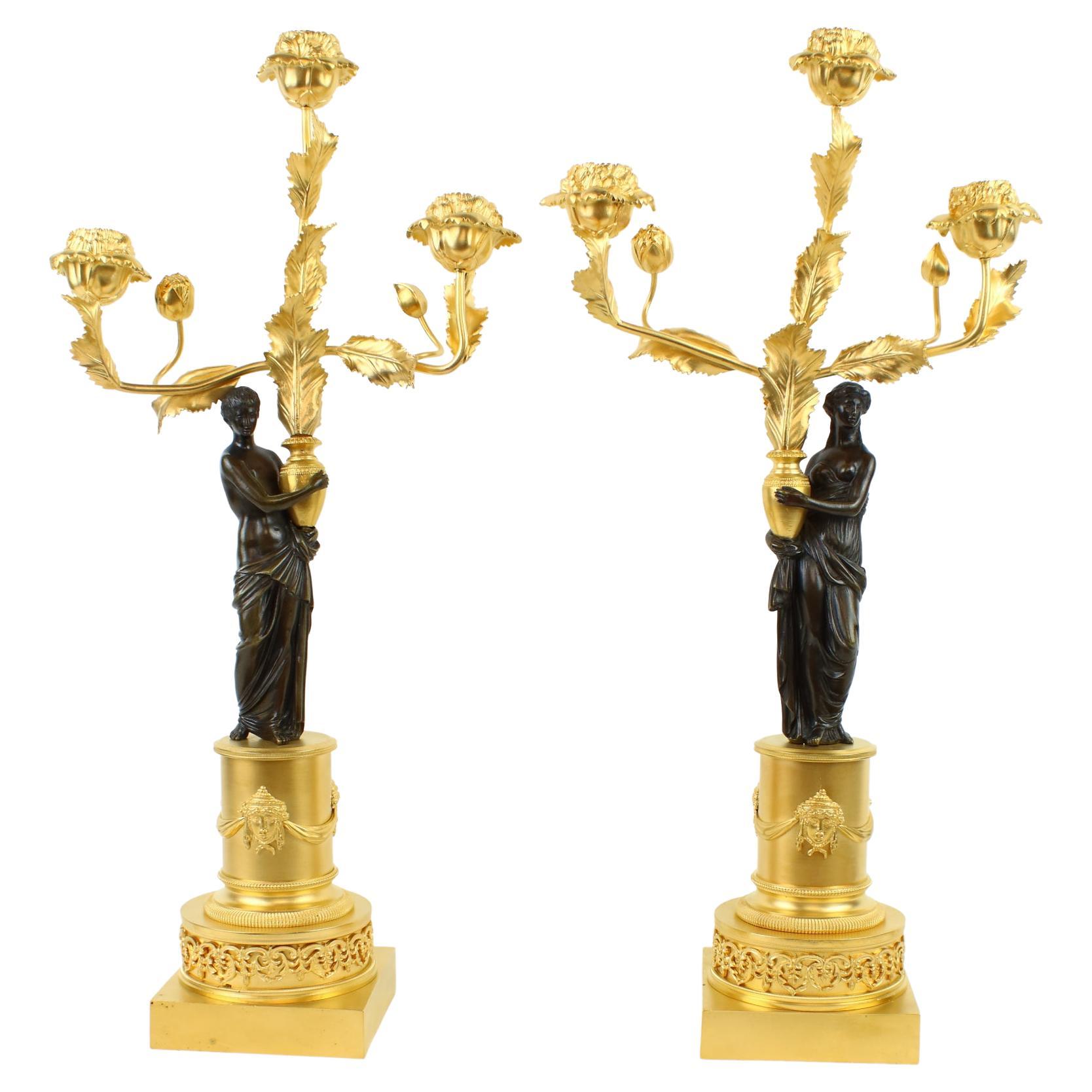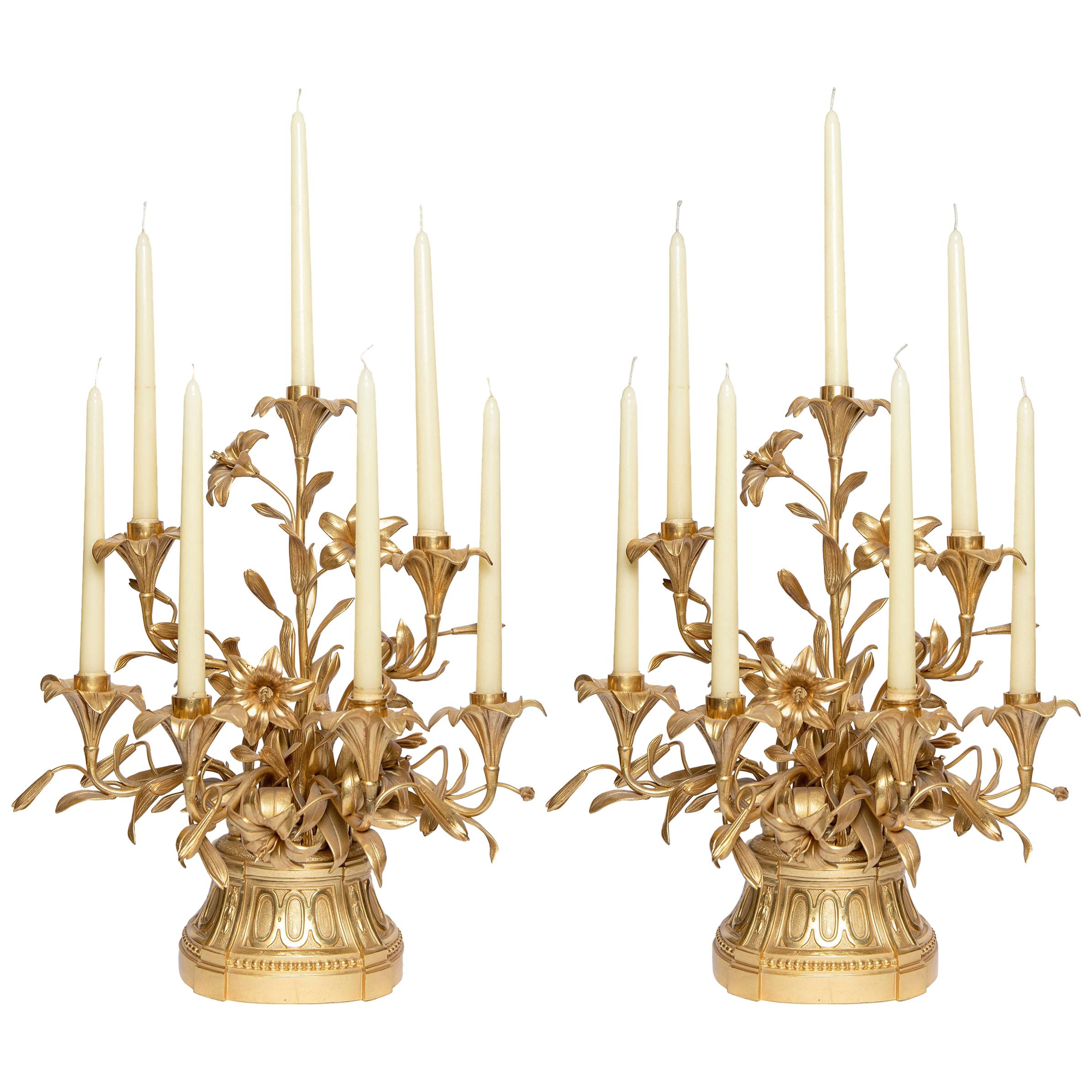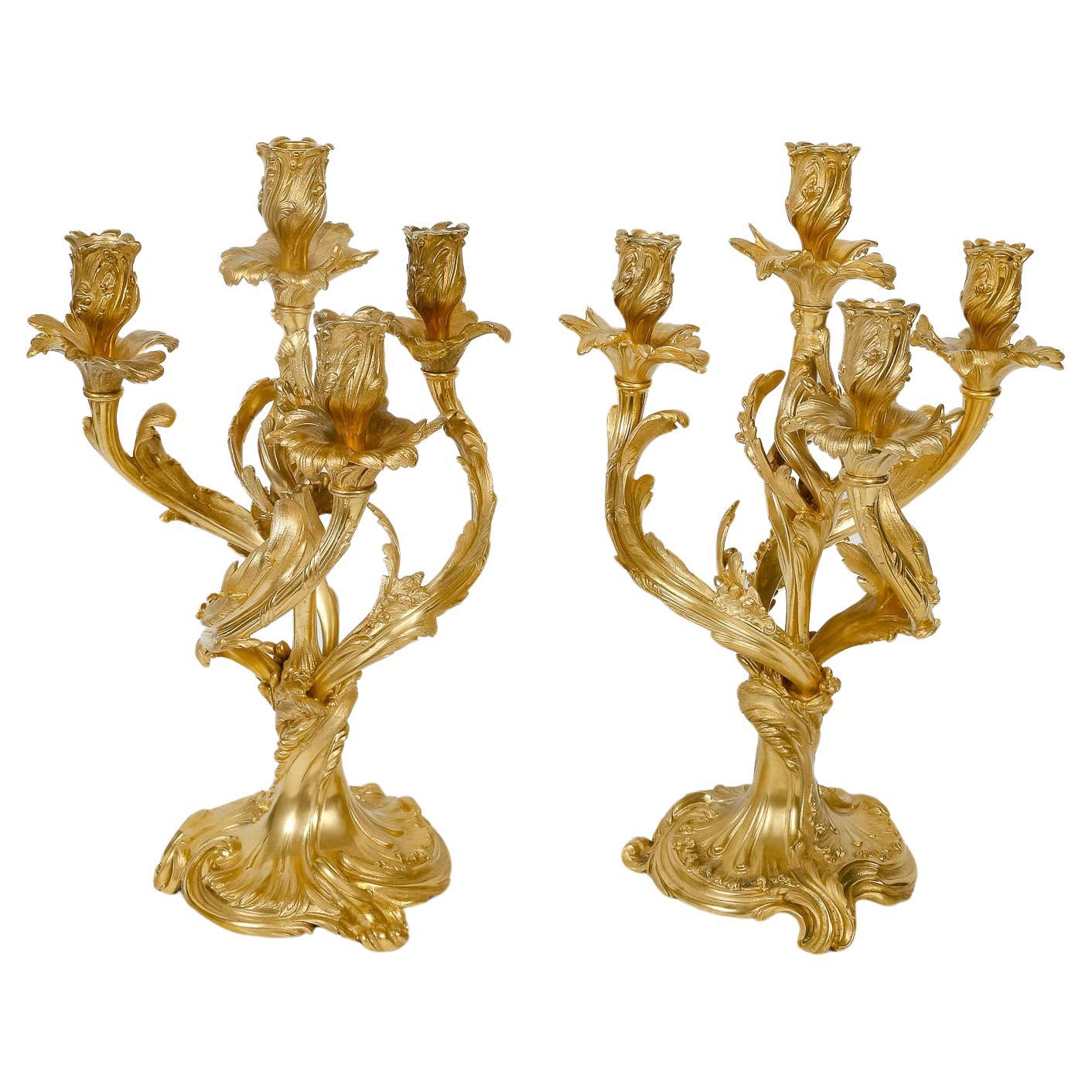Items Similar to 19th Century Pair of French or Russian Gilt Bronze Candelabra, circa 1830
Video Loading
Want more images or videos?
Request additional images or videos from the seller
19th Century Pair of French or Russian Gilt Bronze Candelabra, circa 1830
About the Item
Pair of thirteen-flame candelabra
France or Russia
Second quarter of 19th century
Cast, chiseled and gilt bronze
Height 40.95 in (cm 104), diameter 17,7 in (cm 45)
97 lb (44 kg)
State of conservation: very good: three wax cups (bobèches) have been replaced.
The triangular plinth is composed of a foundation with concave sides surmounted by a similarly configured base decorated with protomes of winged lions and Persian palm motifs. Above this, a sheaf of acanthus leaves wraps the base of a fluted column that tapers slightly upwards to a capital, which reproduces the acanthus leaf decoration. A calyx stands atop the capital and supports the first order of arms, which alternate with extended palm leaves and are adorned with twining acanthus shoots. Each candleholder is decorated with palm leaves and has a wax cup or bobéche. The second order of arms continues the same decorative motif.
The model for these candelabra, characterized by shafts enwreathed in palm leaves and an animal-claw base, draws inspiration partly from ancient marbles and also from early 19th-century drawings by Charles Percier. A later variant, crafted by the famous French bronze-smith Pierre-Philippe Thomire and placed in the State Apartments of the Grand Trianon in April 1837, is described as une paire de Candelabres [...] sur pieds à griffes [a pair of candelabra with animal-claw feet].
If we compare our exemplars with other candelabra from the same period found in the principal European courts and noble palaces, we find a large number of variations on the theme. On the basis of the style, technique and taste, it is reasonable to suppose that these important candelabra are the work of French or Russian artisans working in the second quarter of the 19th century.
Bibliography:
Mosè H., Vasi, altari, patere, treppiedi, candelabri, sarcofagi, London 1814, pp. 85-86
Percier C., in Fontaine P., Recueil de Décorations Intérieures, 1801
LeDoux-Lebard D., Le Grand Trianon: meubles et objects d’art, Paris, pp. 128-129
Filippo Thomire 1751-1843, exhibition catalogue, Leningrad 1984
S. Pietroburgo: arte di carta al Museo dell’Ermitage 1703-1825, Milan 1991
Ceneviere A., Il mobile Russo, l’epoca d’oro 1780-1840, Milan 1989
Ivanova E., (ed.), Russian Applied Art, Leningrad 1976.
- Dimensions:Height: 40.95 in (104 cm)Diameter: 17.72 in (45 cm)
- Sold As:Set of 2
- Style:Neoclassical (Of the Period)
- Materials and Techniques:Ormolu,Other
- Place of Origin:
- Period:
- Date of Manufacture:circa 1830
- Condition:Minor losses. Minor fading. Very good: three wax cups (bobèches) have been replaced.
- Seller Location:Milano, IT
- Reference Number:1stDibs: LU4352214037882
About the Seller
4.3
Vetted Seller
These experienced sellers undergo a comprehensive evaluation by our team of in-house experts.
Established in 1860
1stDibs seller since 2018
19 sales on 1stDibs
Typical response time: 1 hour
Associations
International Confederation of Art and Antique Dealers' Associations
- ShippingRetrieving quote...Ships From: Milano, Italy
- Return PolicyA return for this item may be initiated within 14 days of delivery.
More From This SellerView All
- Pair of French Three-Flame Candelabra Candelabra, circa 1860Located in Milano, ITPair of three-flame candelabra Cast bronze, chiselled and mercury gilded France, third quarter of the nineteenth century Height 14.96 in (38 cm) X 12.59 (32 cm) Weight 11.46 lb ...Category
Antique 1860s French Napoleon III Candelabras
MaterialsBronze
- 19th Century Italian Sterling Silver Madonna, circa 1830Located in Milano, ITEmbossed and engraved silver plaque La Madonna del lago (The Madonna of the Lake) Probably Milan, post 1824 Brass frame It measures 16.14 in x 13.85 in (41 x 35.2 cm) and it weighs 10.357 pounds (4.698 g): silver 1.31 pounds (598 g) + brass 9.03 pounds (4.100 g) State of conservation: some abrasions on the bottom. The frame is old, but not original. The plaque is made up of a sheet of embossed and engraved silver, and held in a solid brass frame. It depicts the “Madonna del lago” – “Madonna of the Lake” - (the Madonna with Child and San Giovannino) by Marco d'Oggiono (Oggiono, 1474 circa - Milan, 1524 circa), while changing only the background landscape. Almost certainly the subject reproduced in the plaque was taken from a famous engraving by Giuseppe Longhi (Monza, 1766 - Milan, 1831), one of the greatest engravers of his era. The silver is unmarked, probably because originally the Madonna was due to be exposed in a church: sometimes precious metals destined for worship and liturgical use would be exempted from payment and were, therefore, not marked. It is very likely that the plaque was made in Milan because in this city in 1824 the engraving by Giuseppe Longhi was made and printed. In addition, in Milan, the alleged lost painting by Leonardo da Vinci in his Milanese period (1482-1500) would be produced; this is the painting from which Marco d'Oggiono took his version. The painting Marco d?Oggiono was one of Leonardo da Vinci's most brilliant students and collaborators (D. Sedini, Marco d’Oggiono, tradizione e rinnovamento in Lombardia tra Quattrocento e Cinquecento, Roma 1989, pp. 151-153, n. 56; p. 225, n. 124, with previous bibliography). His style reflects in every way that of the Tuscan Maestro, so much so that he was the one who executed some copies of da Vinci's paintings. The execution of the “Madonna del Lago” probably draws inspiration from a lost painting by the Maestro, created while he was living in Milan (1482-1500). There are many similarities with other works by Leonardo such as the “Vergine delle rocce” or the “Vergine con il Bambino e San Giovannino, Sant’Anna e l’Agnello”. The painting, from which the drawing and then the famous engraving were taken, is found today at the M&G Museum of Bob Jones University in Greenville, South Carolina, where it came to rest after the sale of the Harrington Collection in London in 1917. The work appears in the inventories of the collection of Napoleon and Joséphine Bonaparte at the castle of Malmaison, before 1809. The Malmaison building was born and developed in the 17th and 18th centuries. In the 18th century it belonged to Jacques-Jean Le Coulteux du Molay, a wealthy banker. Later, during the Directory, Joséphine Bonaparte de Beauharnais bought it on April 21st, 1799, but settled at the castle definitively only after her husband separated from her in 1809. She remained there until 1814, the year of her death. When Joséphine died, the estate passed to her son Eugène de Beauharnais, who moved to Munich with his whole family in 1815, bringing with him the collection of paintings he inherited from his mother. Eugène died in 1824 and his wife Augusta of Bavaria (von Bayern), unable to keep it, in 1828 sold the Malmaison to the Swedish banker Jonas-Philip Hagerman. It is likely that in this period Augusta also sold part of the paintings inherited from her husband, including the “Madonna del Lago”. This painting then came into the possession of Leicester Stanhope, fifth Earl of Harrington (1784 - 1862) and then was passed down to his descendants. In 1917, at the death of Charles, eighth Earl of Harrington, his brother Dudley inherited the title and properties and he put up a part of his collections for sale. Among these, precisely, the painting by Marco d'Oggiono was to be found. On the occasion of that auction the painting was presented as a work by Cesare da Sesto, by virtue of a handwritten note by the Countess of Harrington on the back of the table. However, already in 1857, the German critic Gustav Waagen had identified Marco d'Oggiono as the author of the painting, then exhibited in the dining room of Harrington House in London (Treasures of Art in Great Britain, in 4 volumes, London, 1854 and 1857). The engraving Giuseppe Longhi was one of the most renowned engravers in Italy between the end of the 18th century and the first quarter of the 19th century. In 1824 Giuseppe Longhi, based on a design by Paolo Caronni, made a famous engraving of the painting of Marco d?Oggiono. The activity of Longhi was then at the peak of his notoriety, enough to earn him very substantial commissions; it is not risky to suppose that some of his successful engravings were also reproduced using other means: in our case in silver. (A. Crespi, a cura di, Giuseppe Longhi 1766–1831 e Raffaello Morghen...Category
Antique 1820s Italian Neoclassical Sterling Silver
MaterialsSterling Silver, Brass
- 19th Century Italian Sterling Silver Glass and Wine Coasters, circa 1830By Antonio MantelliLocated in Milano, ITTwelve silver glass coasters and four silver wine coasters. Silversmith Antonio Mantelli Milan, circa 1830 They measure: Glass coasters: 0.78 in high x 3.46 in diameter (2 cm x 8.8 c...Category
Antique 1820s Italian Neoclassical Sterling Silver
MaterialsSterling Silver
- Italian Silver Puerperal Cup or Small Soup Tureen, Milan Circa 1830Located in Milano, ITSilversmith L. B. Small silver soup tureen or puerperal cup with plate and lid Milan, around 1830 Height 19.5 cm (7.67 in) - diameter 21.7 cm (8.54 in) lb 2.14 (kg 0.97) State of conservation: slight use defects and a dent on the plate. From about the mid-16th century, the puerperal soup tureen or puerperal cup became one of the most popular wedding gifts in central Italy. As an auspicious symbol, it replaced the birth table...Category
Antique 1830s Italian Neoclassical Sterling Silver
MaterialsSterling Silver
- Seven Early 19th Century Neoclassical Italian Chairs, Milan circa 1820Located in Milano, ITGroup of seven chairs Milan, first quarter of the 19th century Carved walnut wood, lacquered in gray green and cream and partially gilded They measure: height 36.61 in (18.11 in ...Category
Antique 1810s Italian Neoclassical Chairs
MaterialsWalnut
- 19th Century Italian Wood Mannequin, Circa 1870-1880Located in Milano, ITMannequin Sculpted and carved wood Italy or France, second half of the 19th century. It measures 25.59 x 6.29 x 3.54 in (65.5 x 16 x 9 cm) It weighs 2.2 lb circa (1 kg circa) St...Category
Antique 1870s Italian Other Figurative Sculptures
MaterialsWood
You May Also Like
- A pair of 19th century gilt bronze French candelabraLocated in SON EN BREUGEL, NLA very pretty pair of gilt bronze French candelabra in the style of Louis XV. Each with two candle light. Decorated with foliate motifs and acanthus leaves.Category
Antique 19th Century French Rococo Candelabras
MaterialsBronze
- Pair Russian 19th Century Gilt Bronze and Marble CandelabraLocated in New York, NYExceptional pair of Baltic Russian 19th century ormolu bronze candelabra with rouge marble orbs mounted on bleu turquin marble bases, in the form of a neoclassical atheniennes with e...Category
Antique Mid-19th Century Russian Baltic Candelabras
MaterialsMarble, Bronze
- 18th/19th Century Pair of Russian Figural Gilt and Patinated Bronze CandelabraLocated in Berlin, DEPair of end of 18th/early 19th century Russian neoclassical figural gilt and patinated bronze candelabra. Gilt-bronze circular pedestal on rectangular plinth, the base with neoclassical foliate frieze, the pedestal with surrounding frieze of stylized female masks with Russian-style headdresses, which are connected by draperies. Each pedestal with the patinated bronze figure of either a young man or a young woman in classical garments, each holding a baluster vase from which emerge naturalistically designed, cast and chiselled branches of leaves and roses, the rose flowers serving as bobeches for candles. The detailed and naturalistic design of the rose branches...Category
Antique 1790s European Neoclassical Candelabras
MaterialsBronze
- Pair of Gilt Bronze Candelabras with Flowers, France, Late 19th CenturyLocated in Buenos Aires, Buenos AiresPair of gilt bronze candelabras with flowers. France, late 19th century.Category
Antique Late 19th Century French Neoclassical Candelabras
MaterialsBronze
- Pair of 19th Century Gilt Bronze Candelabra.Located in Saint-Ouen, FRPair of 19th century gilt bronze candelabra. A pair of Rocaille style candelabra, Louis XV, Napoleon III period, 19th century, with four chased and gilt bronze arms. H: 45cm, W: 30c...Category
Antique 19th Century French Louis XV Candelabras
MaterialsBronze
- Pair of French Early 19th Century Gilt Bronze CandelabraLocated in New York, NYA pair of French gilt bronze and patinated bronze four-light candelabra. France, early 19th century. Measures: H 22 in.Category
Antique Early 19th Century French Empire Candelabras
MaterialsBronze
Recently Viewed
View AllMore Ways To Browse
Candelabra French
Decorative Bobeches
Pair French Gilt Bronze Candelabra
Russian Order
Pair Draws
Russia Early 19th Century
1830 Neoclassical Furniture
Large Pair Candelabra
Pair Large Candelabras
Large Antique Candelabra
Candelabra Leaves
1840s French
Cast Bronze Candelabra
Large French Candelabra
Neoclassical Candelabra
Antique Wax Candles
Russian Cast
Large Bronze Candelabras





